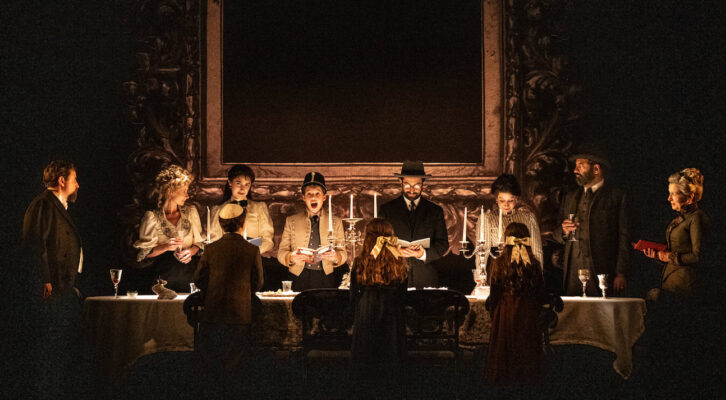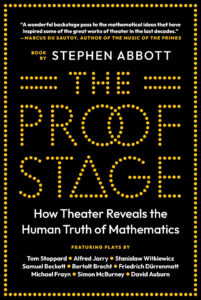
Order vs. Randomness: What Math Can Teach Us About the Stage
Stephen Abbott Helps Make Sense of the Mathematical Underpinnings of Tom Stoppard's Leopoldstadt
Tom Stoppard has been fascinated with mathematics since the beginning of his career. Indeed, this is what originally led a well-behaved mathematician like me to devote so much time to exploring the relationship between mathematics and theater. It was Stoppard’s 1993 play Arcadia that initially grabbed my attention, but I quickly learned that Stoppard had been casting mathematicians long before he knew any mathematics. In the 1966 breakthrough play Rosencrantz and Guildenstern Are Dead, Guildenstern speaks like an Aristotelean logician.
In the follow-up play Jumpers, philosophy professor George Moore invokes Bertrand Russell, Georg Cantor, and the Greek philosopher Zeno in his attempts to prove God exists. Progressively more explicit mathematical stepping stones appear in every decade. Euclidean geometry makes an appearance in Every Good Boy Deserves Favour, Hapgood features Leonard Euler’s Bridges of Konigsberg solution and a sizable dose of quantum mechanics, Arcadia is built around the principles of chaotic dynamical systems, and The Hard Problem employs a host of applied mathematicians to flesh out the debate over the origins of human consciousness.
So perhaps it’s no surprise to find mathematics in Stoppard’s Tony-nominated Leopoldstadt—except that it is. Mathematics is not an obvious fit for the play in which the eighty-year-old Czech-born playwright decided to address his largely unexplored Jewish identity.
The prime numbers offer a fundamental lesson on the question of order versus randomness.
Leopoldstadt is an expansive drama about an extended Jewish family living in Vienna. The first scene is set in 1899, in the living space of a handsome city apartment. It is the dawn of a new century and there is some guarded optimism for the progress of Jewish assimilation into Austrian society. The play then progresses through time—with scenes from 1924 and 1938.
The last scene takes place in 1955, ten years after the war, with exactly three surviving members of the family meeting back in this same apartment. Why would Stoppard feel that this very tragic and very personal play needed a mathematical thread running through it, from end to end in fact?
In the cacophonous family gathering that opens the play, a conversation about Sigmund Freud’s new theory on dreams leads Ludwig to announce that “I sometimes dream I have proved the Riemann Hypothesis.” Mine was surely one of the few hearts to skip a beat at the mention of this monumental, complicated—and still unresolved—problem of analytic number theory. A few moments later, Stoppard offers his audience this more accessible description of what’s at stake:
LUDWIG: If I went to sleep for a hundred years, the first thing I’d ask when I woke up is ‘Has Riemann been proved?’
HERMANN: Why?
LUDWIG: Because if it had, then I could state with certainty how many prime numbers exist below a certain number, however high; and if it hasn’t, then I can’t. Not with certainty.
HERMANN: That is a very annoying answer.
Article continues after advertisement
The uselessness of pure mathematics perplexes Ludwig’s brother-in-law and its beauty eludes him, but that’s Stoppard’s way of helping his audience not make the same mistake. This is a good first step in making sense of Leopoldstadt’s mathematics. Stoppard likely felt he needed something permanent and beautiful to offset the devastating historical landscape the play traverses.
In the sparse final scene set in 1955, a family member named Nathan has survived the death camps and is now a mathematician himself with a position at the University of Vienna. These two truths of Nathan’s life are intertwined. We see the moment in 1938 when Ludwig turns a children’s game of cat’s cradle into a mathematical puzzle that captures the fourteen-year-old Nathan’s imagination. “Is this mathematics?” Nathan says in wonderment. In a sense, this gift from Ludwig becomes a lifeline for Nathan through the encroaching darkness.
The beauty of mathematics has a compelling roll to play in Leopoldstadt, but Stoppard’s career-long affection for mathematics reveals a more ambitious agenda on the part of the playwright. Taken collectively, Stoppard’s mathematically infused plays form a treatise on the tug-of-war between providence and probability as models for the human condition.
The search for root causes is integral to the mathematical universe, and it comes with a faith that there are root causes to find.
The omnipotent roll of Shakespeare’s Hamlet in Rosencrantz and Guildenstern Are Dead is just the first installment in an ongoing debate that takes many forms: Is the universe ordered in some way or is it random? Is it deterministic or do we possess freewill? Are we being looked after by some larger moral intelligence, or is it “turtles all the way down,” as one of his characters says?
What might be surprising is that Stoppard most often employs mathematics in defense of the irrational or divine side of this equation. Whether it’s Zeno’s paradoxes in Jumpers, the mathematics of the atom in Hapgood, chaos theory in Arcadia, or Gödel’s Theorem in The Hard Problem, mathematics is most interesting to Stoppard when it is being invoked to argue for the persistence of some degree of uncertainty.
Which brings us back to Leopoldstadt and the distribution of the primes. The prime numbers offer a fundamental lesson on the question of order versus randomness. On inspection, the primes certainly appear to be spread out among the whole numbers in a haphazard way. Yes, they become less frequent as we count our way up through the integers, but there is an unpredictable quality to when the next prime appears. It’s as though the numbers are being a bit capricious. But, of course, nothing could be less capricious than the behavior of the positive integers! “There is order here, mathematical order,” Ludwig says, “but how can we find it?”
Ludwig makes this statement during the cat’s cradle game with Nathan. In this moment, Ludwig is actually referring to the changing patterns of the string, not the elusive pattern of prime numbers, but the comment applies perfectly in either case. The search for root causes is integral to the mathematical universe, and it comes with a faith that there are root causes to find.
Does this faith extend to the moral universe? Stoppard has been arguing both sides of this question for nearly six decades, revealing along the way his bias for the persistence of places that reason cannot take us. In Leopoldstadt, the stakes are tragically higher. “The rational is at the mercy of the irrational,” Ludwig’s brother-in-law argues late in the play. “Barbarism will not be eradicated by culture.” Minutes later, the Nazis come through the apartment door.
In the end, Leopoldstadt’s deeply human story needs a mathematician, and a mathematician’s faith, to address unresolved questions more weighty and less tractable than the Riemann Hypothesis.
__________________________________

The Proof Stage: How Theater Reveals the Human Truth of Mathematics by Stephen Abbott is available from Princeton University Press.
Stephen Abbott
Stephen Abbott is professor of mathematics at Middlebury College, where he has been teaching for thirty years. He is the author of the widely used textbook Understanding Analysis and theater events chair for the Bridges Organization, a professional association dedicated to exploring the intersection of mathematics and art.



















